All the cast-ons in the world can be divided into two categories: short-tail cast-ons and long-tail cast-ons. In a long-tail cast-on, two strands of yarn are used: the working yarn and a long piece of tail yarn.

You can ONLY use a long-tail cast-on to START a knitting project, because when you’re in the middle of a project, you only have one strand of yarn available to you.
If you need to cast on in the middle of a project, you can always do a short-tail cast-on, in other words, a cast-on that requires only one strand of yarn.
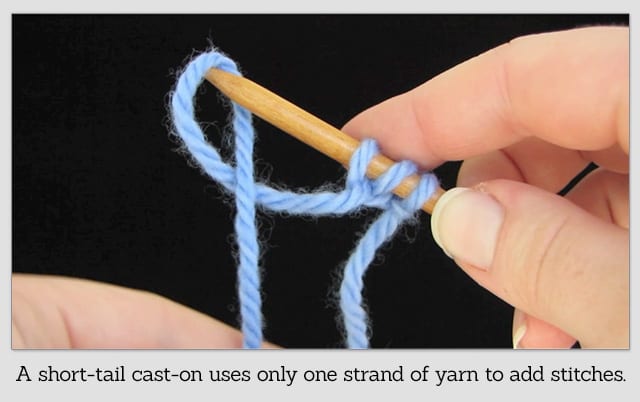
The “short tail” refers to the six-inch tail you leave hanging from the slipknot to be woven in later.
Which to choose?
Long-tail cast-ons are generally much faster to do, although until you get good at estimating how much tail you’ll need, you might waste yarn if you estimate too much.
When you are casting on for the beginning of a project, you will generally be casting on a large amount of stitches, so choose a long-tail cast-on unless there is a short-tail cast-on whose edge you greatly prefer.
Popular long-tail cast-ons are:
- the Long-Tail cast-on,
- the Old Norwegian cast-on
- the Double-Start (Estonian) cast-on, and
- the Channel Island cast-on.
If you are in the middle of a project and your pattern calls for you to cast on more stitches, choose a short-tail cast-on.

The knitted cast-on is a very easy short-tail cast-on based on the knit stitch.
As you can see, it can be used to add stitches onto the side of your knitting at any point in your project.
It is moderately stretchy but only semi-durable- it tends to get stretched-out with use.
…
To do it, knit into stitch on the left-hand needle and then place the new stitch knitwise onto the left-hand needle. Then, knit the cast-on stitches through the back loops to tighten the cast-on.
Some of my favorite short-tail cast-ons are:
- the Cable cast-on,
- Tillybuddy’s cast-on, and
- the Chinese Waitress cast-on.
Video explanations of all these cast-ons and more available in…
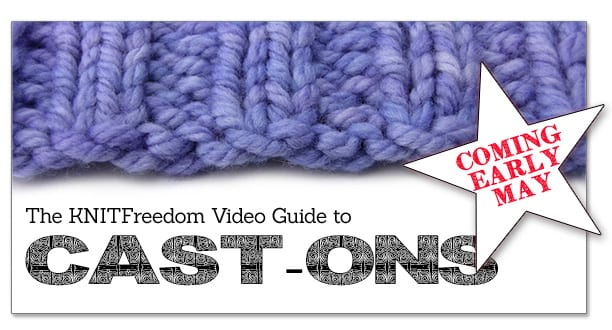
This lesson is a small part of the upcoming video knitting course, The KnitFreedom Video Guide To Cast-Ons, coming out in early May 2013. Watch your email inbox for updates!
KnitFreedom pattern that uses a short-tail cast-on to cast-on in the middle of a project: “It’s Time to Knit!” Leftover Sock Yarn Wall Clock Pattern
Leave a Comment
Did you learn something new from this post? Have a question? Leave a comment and let me know!
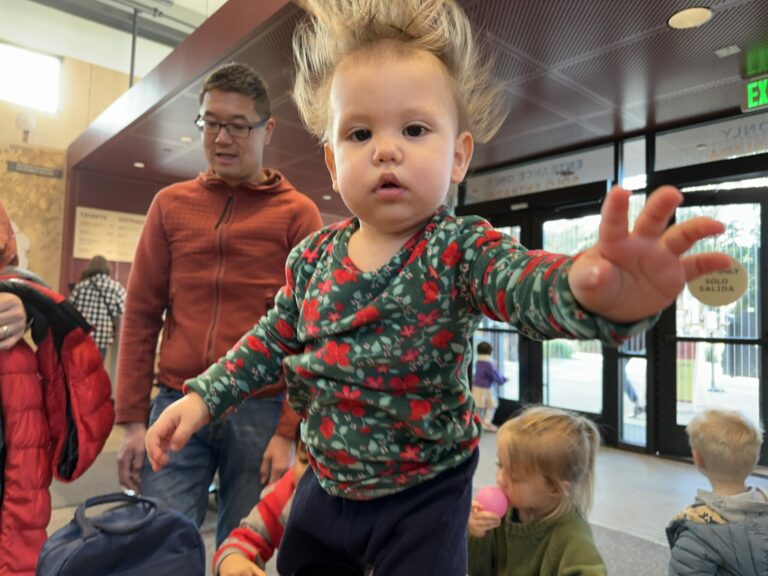
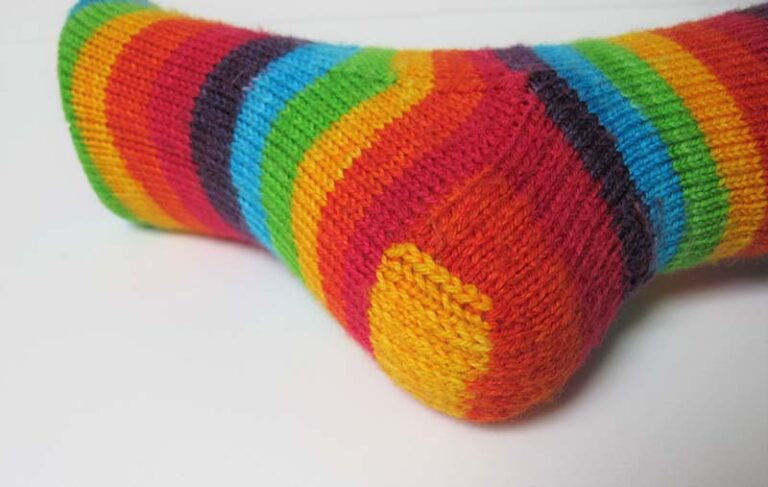
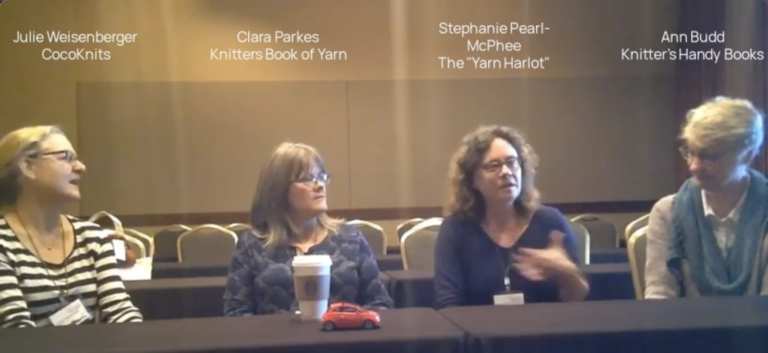
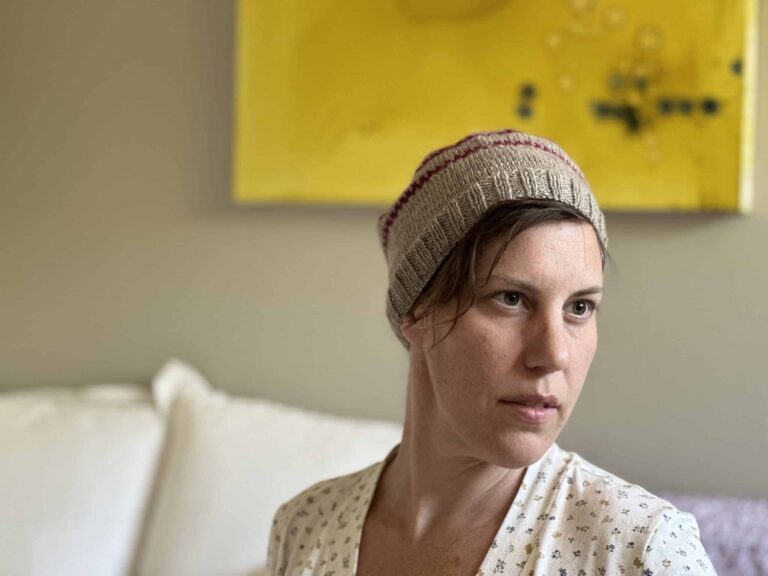
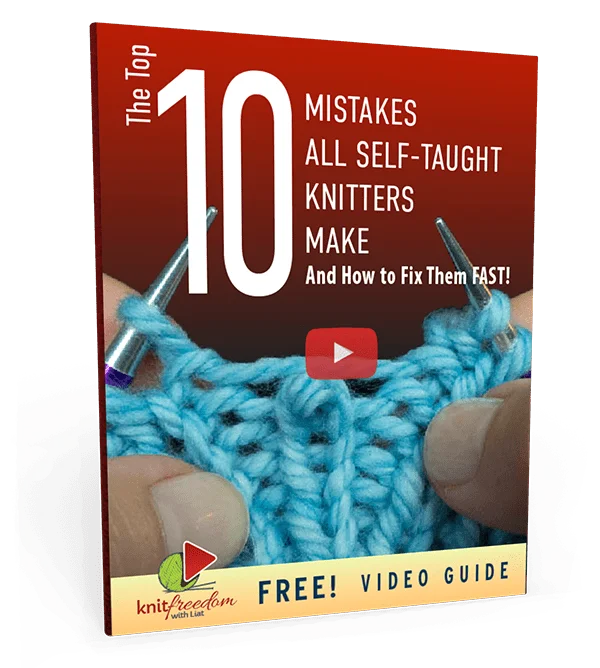

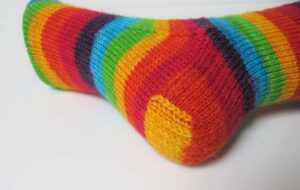


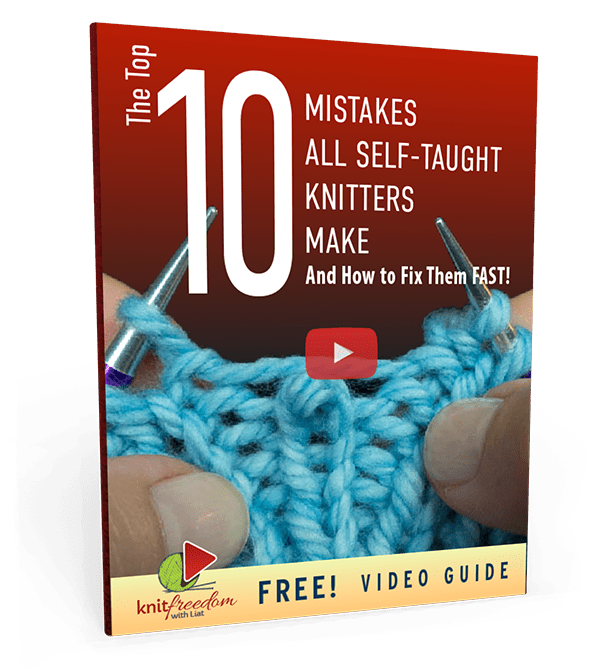
101 thoughts on “Short-Tail or Long-Tail? The Fundamental Difference Between Cast-Ons”
Help! I’m an old lady knitter starting when I was 12. I can’t understand or master the long tail cast on!
Hi Suzanne,
Here is my video on the Long-Tail Cast-On. I know you can do it. Please let me know if you try it and are still confused. Believe in yourself! The word “can’t” will mess you up. Just instead say, “I haven’t mastered it yet!”
https://www.knitfreedom.com/knitting-video/long-tail-cast-on-2/
Cheers,
Liat
Can not wait to see the video!
I tried the Chinese Waitress Cast On last evening. I love it! It’s slow going & fiddley, but good for so many edges….it’s like a double-edge….quite pretty.
Yay! You’ll get faster at it. :)
I’m so glad!
Holy cow, am I ever glad you are back!!! Hope you are 100% healed and don’t overdo it at first. I have sure missed your tips and videos, Liat. You are the one person who has the most understandable instructions and the most detailed videos and I have the most “aha!!!” moments watching them! I have recommended your videos to more people.
Again, thank goodness you are well and back with us. We missed you!!!!!
Jennie in GA
Thank you Jennie! You make me so happy!
Liat, looking forward to the video in May.
Liat, if I use the long tail CO, would the first knitted row be wrong side (WS) or right side (RS)? I always forget and simply use the pattern but always wonder if both ends of, say a wrap, will look the same. It seems like I read that some CO’s are considered row 1, or RS, and some some CO’s say to start with row 2 which would be the RS. It’s confusing.
Emma, that’s a great question.
I explain it in-depth in the upcoming ebook, but the short answer is: for long-tail cast-ons, you are creating the first right-side row as you cast on.
Therefore, the first row you work after the cast-on is a wrong-side row (so if you are doing Stockinette you would purl).
Great names for some of the cast-ons. Can’t wait to see them in person.
I know, right? Glad you’re excited!
Sometimes my ribbing will curl forward. What causes this. Does it make a difference which caston I use?
Hm, ribbing is supposed to lay flat. Yes, there are certain cast-ons that are meant specifically for ribbing, like the Italian tubular cast-on. I go into this concept in-depth in the upcoming ebook and give you lots of cast-ons to try that work well with ribbing and should lay flat.
Thank you so much, I learn a lot from your e-mails., had never used the long tail cast on for anything. Have knit for years, but learn something new everyday.
I’m so glad! The long-tail cast-on and its fancy cousin the Old Norwegian cast-on are both fast to do and look really nice.
Loved the tip about tightening up the short tail cast on.
Thanks, Pat! Yes, for the knitted and purled cast-ons especially they come out much nicer if you work them through the back loops.
I learned how to knit when I was 8, many, many, moons ago, I haven’t done any for about 20 years and this past year have restarted. I decided to try learn the continental style of knitting which I’m finding difficult with ever stiffening short fingers but I’m improving slowly, thanks to Liat’s video. Like a few have already said, I didn’t realize there were so many different ways to cast on. Very interesting. Thanks Liat for all your hard work. I thought I knew how to knit but realize now there’s so much more to learn.
Hooray! Elly, thank you so much for sharing your story! It makes me so happy to know I have opened up new doors for you in knitting! There is always more to learn. :)
Please note my new e mail address. [email hidden]
Former. [email hidden]
Hi Sue, we’ll take care of it!
thanks! I did not know about knitting into the back loop to tighten up the knitted cast on stitches.
Liat!
I always learn something new from you…even if it’s something I forgot a long time ago!
I think you are great!
Thank- you for becoming my “go to” guru!
Gretchen
Thanks Gretchen! I’m so happy you like these little tips. :)
I think this information would be very beneficial for me to learn.
Good info to know and has helped in my knitting. Looking forward for more info .
So glad this has helped! I think you’ll like the upcoming Cast-Ons ebook.
Great info always clear . Looking forward to the new vids . Thanks Liat!
Can’t wait to see these cast ons! Many are new to me. Love your videos – save them all! So good to see you back – take care!
Aw, thank you Sandi! I hope to keep bringing you new tips and things you haven’t learned before. :)
Liat,
At my local yarn shop the owner Sandee taught me that you can do the long tail cast on without having to estimate by using the yarn from both ends of the ball. So after you cast on , you cut the yarn from the end of the ball. No estimating or wasting.
I LOVE all your videos. They are a huge help when I cannot get to Yarns With a Twist for help!
Cindy
Thank you Cindy! I have definitely included this trick in the upcoming ebook- it’s a brilliant one!
The Chinese Waitress cast on? Very intriguing!!
I know, right? I’m publishing it this Wednesday, May 1st. Not too long to wait! :)
Really I didn’t know there were so many different cast on’s . I found this CO that uses a crochet hook and it doesn’t waste any of my yarn, simply called Crochet Cast On. I love that your making these videos on this.
Someone asked the question of How do you estimate for long tail? I was taught to wrap the yarn around the needle ten times ,one loop for each stitch , then pull off of needle and use the length to measure more yarn from until you have the amount needed .Say I need 30 stitches, I hold the yarn that I wrapped and bring more yarn up to match the same length two more times. Ok, now that I’ve said that I don’t know how to explain it better without making it more confusing :( does that make any sense ? It does work.
Great tip! I knew about wrapping for each stitch but never knew about the ten stitch trick.
Oh, good! Yes, it really helps you not waste yarn. :)
Yes, it makes since & yes, it works. That’s the fastest way to do it, Rosie.
Mary
This is a GREAT tip! I always over-estimate and have to cut precious inches of waste yarn. I haven’t tried toe-up socks yet, but I really want to. So until I ‘take the plunge’ I’m trying the 10-stitch wrap trick. Thanks so much for the tip!!!
Woohoo! I have a tip coming up for you next week about estimating tail that you’ll really like…
Hi Rosie,
I really like the crochet cast-on, too. It perfectly matches the traditional bind-off, which I love.
Your tips about wrapping the yarn around the needle 10 times is a very good one. I have included it in my upcoming ebook, too, so that everyone can learn it.
I never realized there were so many different types of cast ons. I learned to knit using the long tail method, so that’s the one I’m most comfortable with. When I have to add on stitches, I used the short tail method. I would love to try the knitting method. Can’t wait for your video! Thanks so much!!
You’re welcome, Cheryl! There are so many fun cast-ons. Now that I’ve filmed the ebook I have new favorites, like the Old Norwegian cast-on for my go-to long-tail cast-on, and the cable cast-on, Tillybuddy’s cast-on, or the Chinese Waitress cast-on for my fave short-tail cast-ons. You are going to love them! The knitted cast-on is just the beginning… ;)
I am so glad you are back —- I am starting a new pair of socks and I am using the “Judy’s Magic cast-on. Love the toe up socks, they fit so much better. Again SO HAPPY YOU ARE BACK?
Yay! Thank you so much, Jean! It’s SO good to be back!! I’m happy you’re knitting toe-up socks – you are on the fast track to Knitting Superstardom!
Not this time…but, I love and enjoy your emails. Thanks
my speling is not good bud in german i am i am so hppy i found you i never know about the short row i feel so lucky nou if i culd find inaxspency jahrn i have it maed
also wher cud i find a videos four c swether ? thank you so matsh waltraud
Walt,
Have you tried eBay for inexpensive yarn? If you buy from an eBay seller from Germany, the shipping would be less expensive (cheaper).
I too would like a sweater pattern from Liat because she explains how to knit things better than anyone else I’ve found.
Good Luck!
Mary
Thanks Mary! I definitely have one or two sweater ebooks on my “to-do” list. :) I’m excited to demystify basic and custom sweaters for my students.
Hi there! You can always write in German and I can use Google translate to read it. I will be making a video class all about sweaters in the future, so stay tuned!
Learned two things – so always grateful knit-on cast on will stretch with use – and when knitting the knit-on cast on, knit through the back to strengthen. Glad you’re back.
Hooray Karen! Thank you :D
No meaning to hurry you Liat, but could we also have another piece on cast-off’s? I would be so grateful to find some videos of different – and matching where possible – examples. Thank you so much for all the wonderful learning you give us all.
Hey, Janet, of course you will have a course just for cast-offs! I intend to do that one either next or right after the Lace course.
Also, in the cast-ons ebook I will be linking to matching bind-offs if I already have them up on the site.
Many thanks. It was simple and easy to understand.
Well, you read my mind on this one! I was just starting a new project and it has buttonholes and I’m going to have to do cast ons right in the middle of it. Don’t have a clue on this one, so can hardly wait to see the video’s!
Hooray! The ebook is launching on May 10th, so you won’t have long to wait at all. :)
I can’t wait to see these, as I don’t know most of them. I hope they are helpful. I am self-taught for these, and left handed, so I do everything with the wrong hand. It makes looking at videos a challenge sometimes.
Hi Pamela, I think you really will find them helpful. I know it’s harder when you knit left-handed. Maybe watch the video in the mirror?
Hi, I just wanted to thank you for all your tips and advices, because even though I think I can knit, there still are million things it’s better to know. And here you’re coming handy… awesome!!!
Cecilia I’m so glad! It happens to me too, I’m always learning new things. I learned so much while writing and filming this new cast-ons ebook…. I hope you like it!
I never realized there were so many cast-ons. I will be eager to learn more about each one.
I had never heard of 2-ball cast on and can’t wait to see just how it’s done. I am excited about you explaining pros and cons of the various cast on methods. I had no idea the knit CO was not sturdy in the long run and tended to stretch out over time. This type of information is invaluable and it’s the stuff no one ever tells you. Thanks.
Oh good! I’m glad to know those details are helpful – I’ll make sure to continue to research and include them in the future.
I love all your videos and information. I sure glad I found you. Do you have a badge I could add to the blog?
Hi Anita! I’m so glad you are finding this all useful. I don’t have a badge but it would be great if you could link to me on your blog like this: “A great knitting videos website” or something like that. When you use descriptive words to link to me it helps a lot. Thanks!
Can’t wait to see this Chinese Waitress cast on! This is a new one on me.
It’s really fun! I’m publishing it tomorrow, May 1st.
I use long tail for everything. So much so that I have to look the How-To if I need a different CO. Have 2 ways to decide how much yarn I need for a CO.
1. Estimate 1″ per stitch – or –
2. Wrap yarn around needle the same number of times as the number of stitches I need to have.
If I want a long tail for sewing I just leave 6″ extra.
Can’t wait to see your video!
Thanks – good idea.
Hey Liat,
So glad to have you back. Take care of yourself. Looking forward to whatever you have for us next – it is sure to be great!
Linda
Looking forward to these cast on’s…..I usually use the long tail but would like to learn others as knowledge is always a good thing !
Thanks for all you do
Liat, I am so happy you are back and hope you feeling much better. I look forward to getting this course. Love all the ones I’ve bought so far. You’re the best!
Thanks! I’m so happy you like my videos! I really think you’re going to like the new one about cast-ons. I learned so much- I think you will too.
Long-tail is my favourite…
This will be a valuable tool to have in the bag! Your explanations are always so clear and logical. Thank you for that.
Yay! Thanks Marlene!
Yes, would love reviews of Tubular, & Invisible cast on. Hurry, Liat….lol…we can’t wait…lol!
Haha Mary, you’re awesome! You won’t have to wait much longer… the ebook is launching on Friday May 10th!
Very informative. I also use the 2 ball long tail (or either end) for large COs. I need help with the provisional COs. Just don’t get it – don’t know why since I already know how to crochet!
Joanne, in the upcoming ebook I teach two different provisional cast-ons, one with a crochet hook and one without. I bet you will get the hang of both of them!
I’m hoping you will cover the tubular cast on in this video. I don’t get it!
I will! You will totally get it. I promise!
I don’t know if you address this in your future video offering, but I learned a trick for a long tail style cast on that never wastes yarn. I use it if I need to cast on more than 50. Either use two balls of yarn or use each end of the same ball. Leaving 6 inches on each ball, make a slip knot using both. Hold as for the long tail cast on and cast away! At the end, you’ll have to choose one to cut, depending on whether you want to knit from the center or from the outside. No waste and no worry!
Hey Cindy, I absolutely have this tip in the upcoming video. Love it!
Brilliant! Thanks
The Cast ON VIDEO IS COMING
THE CAST ON VIDEO IS COMING
THE CAST ON VIDEO IS COMING
ONE IF BY LAND, TWO IF BY SEA
(CAN YOU TELL I LIVE IN BOSTON?)
LIAT, CAN’T WAIT!! XO
Kathy you are awesome!!! {{{hugs}}}
Liat, I disagree — you can use long tail anywhere! You would use a separate piece of your yarn as the tail. Of course, you would have ends to weave in, but in some cases it may be more desirable.
Good point! If you have to cast on a lot of stitches it would be faster to attach a second piece of yarn.
How do you estimate for long tail?
That is in the upcoming ebook! :)
Wrap the yarn around the needle, leaving your 6 inch or so tail hanging off the end of your needle, as many times as you have stitches to cast on. Add a few inches for a fudge factor and make your slip knot at that point. I found at first I added too much fudge factor. Now I add about 2 inches and it works out perfect.
Thank you, Rebecca! Lou
Rebecca, hope u got my thank u! New with this IPHONE!
About the long tail cast-on: For years I used the slip knot as in the picture, until it dawned on me, that I could just pick up the yarn between thumb and index finger on the left hand, pull back the needle with the yarn and hold it with my right index finger, while I cast on the next stitch. No knot and immediately you have two stitches on the needle. Hope this explains clearly.
Yep! Good point!
Tove is smart!
Liat, I so enjoy hearing from you. Going to start socks. Have a great day!